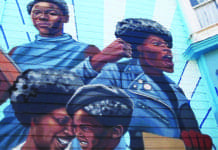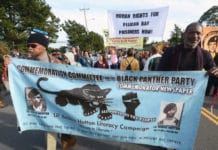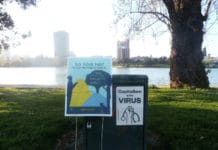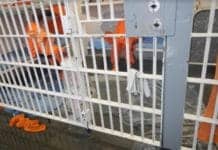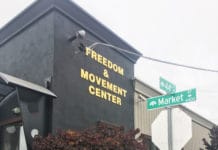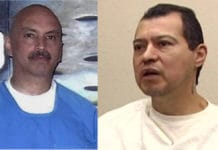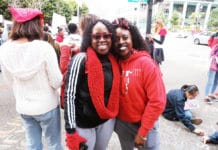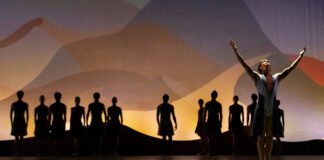by Wanda Sabir

This legislative curiosity theme was affirmed by many All of Us or None members who’d lobbied legislators earlier that morning (the 7:30 a.m. BART carpool shift). One friend, Brother Fred Abdullah spoke of how clueless and uninformed about the situation most if not all of the four politicians he met with that morning were. Later on, the two rows directly in front of the panelists were filled with unidentified men and women, all members of the California legislative team or CDCR staff. I watched their shifting body language – arms folded across chests, legs crossed. Boredom was not evident even in the face of such physical indicators of denial.
State Capitol Room 4202 was full from the balcony to the main floor – it was good the California Department of Corrections and Rehabilitation panel (CDCR) presented last. They would have been laughed out the room – their presentation so absent of any real data, especially when it came to the sentencing standards for prisoners sent to secure housing units or SHUs. From the first panel with a former SHU inmate, Earl Fears, SOULJAHs, The Movement, a family member of an inmate at Pelican Bay, Glenda Rojas, and an articulate clergyman, Rev. William McGarvey, Bay Area Religious Campaign Against Torture, to the panel of experts presenting research perspectives on SHU, the lobbyists against SHU confinement presented irrefutable arguments. I called them the A-Team.

There was a lot of history about Pelican Bay, its construction and CDC’s hopes based on a new model addressing gang activity called the Security Threat Group Identification and Management Policy or STG. Certification, Debriefing, Observation, Risk Assessment, Security Threat Group (STG), Security Threat Group Member, Security Threat Group (STG) Suspected Member, Sensitive Needs Yard, Threat Assessment, Validation, heinous and contested policies can all be traced to the 2007 adoption of The Security Threat Group Identification and Management Policy, which supposedly “incorporates national standards and approaches to the handling of security threat group (STG) members housed in California’s adult institutions” (CDCR Policy Statement).
The second panel shifted the narrative to an analysis of CDCR policy of solitary confinement and sensory deprivation with opening comments by Charles Carbone, J.D., prisoner rights attorney. Carbone spoke about the whole gang culture paranoia which seems to define CDCR policies, especially at Pelican Bay. He showed how having the high maintenance population in the SHU didn’t decrease crime or make the prison any safer. In fact, the opposite was true. Sensory deprived, the fact that these men were willing to sacrifice their lives for an opportunity to break the silence and expose the conditions of their confinement, a sentence not based on a verdict by a jury of their peers, rather on the word of a bureaucrat at Pelican Bay on the word of someone forced to debrief or snitch for favors. The accused could find himself plucked from circulation 8-10-22-32 years – the sentence indeterminate which could mean life.
Former SHU inmates speaking at the rally earlier that morning shared how they were recovering from solitary confinement, PTSD and other psychoses associated with such treatment, how they needed continual psychiatric help post-SHU, how the SHU permanently affected their ability to function in society.

SHU inmates cannot have colored pencils or hobby crafts, photos or contact visits. One woman spoke of how her niece would like a photo of her dad. Mothers spoke of the prison’s refusal to allow their visits. One mother hasn’t seen her son in six years. Another mother said her grandson hasn’t seen his father since he was two, he is now thirteen. One man cried as he recalled the torture he was subjected to in the SHU. Holding his daughter he spoke of the arbitrary nature of the abuse which for him continued when he was released in the form of police harassment.
Dorsey Nunn, executive director of Legal Services for Prisoners with Children and All of Us or None, spoke of his first visit to Pelican Bay. Tuesday, Aug. 23, was his wedding anniversary and he’d planned to go to the cemetery and reflect. He told the story of JT, who has been in the SHU since 1988. The man is losing his color – melanin is not magic. JT has been eligible for parole for 35 years. It’s these men, the leaders, who are targeted by administration, the ones who write the 602s, prepare writs and call into account their captors.

It was the uninterrupted procession of voices from the audience: children, parents, friends and advocates that eloquently closed the day. One woman spoke of how CDCR denied her brother from donating his kidney to his sister, a match, and she subsequently died. One man was promised a phone call and then at the last minute stipulations were made – he had to debrief. Two women, one an attorney, were able to share first hand stories and relay messages from the men, whom they’d seen just a week ago. One of the requests was for better more nutritious food from vendors, tapes for mental health, proctors for educational exams, and a larger property allowance – now the men can only have one shoebox full of personal belongings.
I wished I’d been able to get over to the Crocker Museum to unwind, reflect and process the experience. As it is, I sat in a TJ parking lot, writing under a street lamp, my car light shorted out.
The CDC tacks on the R – when the idea of rehabilitation in an environment structured to inspire fear is ridiculous. The questions Assemblywoman Holly Mitchell raised about the arbitrary nature of CDCR policies as relates to SHU inmates were on point and showed how out of control this California department is. That the head of CDCR, Secretary Matthew Cade could not appear at this important and unprecedented hearing was a further slap in the face of this process and an indictment as to how far Assemblyman Tom Ammiano and other elected officials will have to go to address this injustice. At the rally when I spoke to the Assemblyman he said he was determined to host other such conversations, like one already on the death penalty. He said, he didn’t think there were two sides and that he wanted to shine some light on the subject and get people to start discussing this issue and coming up with remedies that (legislators) could push forward. He said he didn’t “want to be stonewalled too much – I understand things move a little slowly but I don’t want to be put off, so I plan to have other hearings, report back hearings (addressing) any commitment to change from the CDCR. We are looking at this (Hearing) as the very first step.”
Ammiano legislative policy supporters Skinner and Mitchell and Hagman gave strong comments and asked tough questions of Scott Kernan. We hope this hearing touched, as the chair said, the compassionate side of people in the room with the hope that change is not up to CDCR (smile). We also hope the next hearing is at Pelican Bay in Crescent City. To stay abreast of Pelican Bay news, check out: http://prisonerhungerstrikesolidarity.wordpress.com and www.sfbayview.com and also check out several special shows on Wanda’s Picks radio featuring Dorsey Nunn along with a mother, Dolores Canales, whose son is in the SHU, Elder Freeman, Manuel La Fontaine, Linda Evans and Deirdre Wilson. Linda was the emcee at the rally Aug. 23. Another recent interview is with LSPC attorney Carol Strickman: www.wandaspicks.asmnetwork.org.
Bay View Arts Editor Wanda Sabir can be reached at wsab1@aol.com. Visit her website at www.wandaspicks.com throughout the month for updates to Wanda’s Picks, her blog, photos and Wanda’s Picks Radio. Her shows are streamed live Wednesdays at 6-7 a.m. and Fridays at 8-10 a.m., can be heard by phone at (347) 237-4610 and are archived on the Afrikan Sistahs’ Media Network.

 Store
Store




